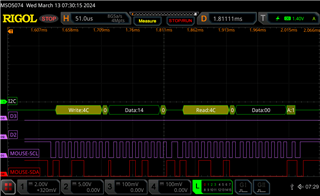Other Parts Discussed in Thread: LP87644Q1EVM
I have a custom PCB that uses an LP876441B1RQKRQ1 and PIC to control it via I2C. The code has been tested with the LP87644Q1EVM and a PIC dev kit and there wasn't an issue enabling and changing the buck's voltage. On the PCB however there's been issues communicating in a general sense. The I2C lines are working, but it's just receiving 0x00 from LP8764, and enabling and controlling the chip doesn't seem to work.
I've verified that the i2c address is 0x4C by trying 0x48 (EVM address) and getting NACK errors, so it confirms that I2C is "working" with at least acknowledging the address. The most baffling part is that I was able to get it to work once, where each buck was enabled and outputting the correct voltage, but multiple power cycles and retries from the PIC have resulted in the same issue of nothing really happening. There was also a short period where the I2C was returning actual values, but again, a power cycle seemed to put it back in its current state.
I'm not sure if there's something I'm missing, or if there's a startup condition that's causing this issue. I've attempted to delay configuration by 5+ seconds after power is applied but that had no change. Verified that VDD_LDO has about 1.8V output. The actual circuit is the same as the LP87644Q1EVM, with a slight difference being the feedback is setup, although it's not configured in the chip.
Any direction would be greatly appreciated.




